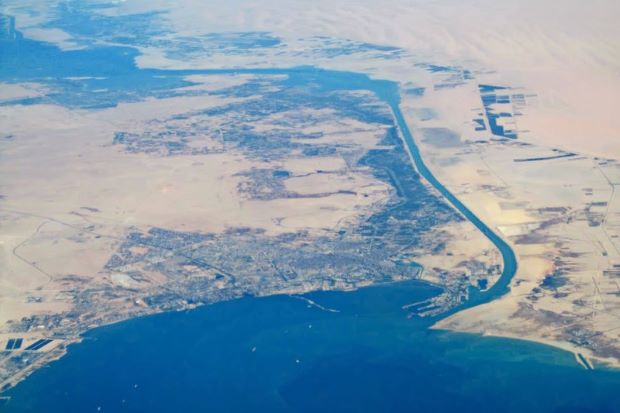On this day in 1859 ground was broken at Egypt’s Port Said for the Suez Canal, an artificial waterway intended to stretch 101 miles across the isthmus of Suez and connect the Mediterranean and the Red seas. Ferdinand de Lesseps, the French diplomat who organized the colossal undertaking, delivered the pickaxe blow that inaugurated construction.
Canals have been built on the Suez region, which connects the continents of Asia and Africa, since ancient times. Under the Ptolemaic rulers of Egypt, a channel connected the Bitter Lakes to the Red Sea, and a canal reached northward from Lake Timsah as far as the Nile River. These canals fell into disrepair or were intentionally destroyed for military reasons. As early as the 15th century, Europeans speculated about building a canal across the Suez, which would allow traders to sail from the Mediterranean to the Indian Ocean via the Red Sea, rather than having to sail the great distance around Africa’s Cape of Good Hope.
The first serious survey of the isthmus occurred during the French occupation of Egypt at the end of the 18th century, and General Napoleon Bonaparte personally inspected the remains of an ancient canal. France made further studies for a canal, and in 1854 Ferdinand de Lesseps, the former French consul to Cairo, secured an agreement with the Ottoman governor of Egypt to build a canal. An international team of engineers drew up a construction plan, and in 1856 the Suez Canal Company was formed and granted the right to operate the canal for 99 years after completion of the work.
Construction began in April 1859, and at first digging was done by hand with picks and shovels wielded by forced labourers. Later, European workers with dredgers and steam shovels arrived. Labour disputes and a cholera epidemic slowed construction, and the Suez Canal was not completed until 1869—four years behind schedule. On November 17, 1869, the Suez Canal was officially inaugurated in an elaborate ceremony attended by French Empress Eugenie, wife of Napoleon III. Ferdinand de Lesseps would later attempt, unsuccessfully, to build a canal across the Isthmus of Panama. He died in 1894.
When it opened, the Suez Canal was only 25 feet deep, 72 feet wide at the bottom, and 200 to 300 feet wide at the surface. Consequently, fewer than 500 ships navigated it in its first full year of operation. Major improvements began in 1876, however, and the canal soon grew into one of the world’s most heavily travelled shipping lanes. In 1875, Great Britain became the largest shareholder in the Suez Canal Company when it bought up the stock of the new Ottoman governor of Egypt. Seven years later, in 1882, Britain invaded Egypt, beginning a long occupation of the country. The Anglo-Egyptian treaty of 1936 made Egypt virtually independent, but Britain reserved rights for the protection of the canal.
After World War II, Egypt pressed for the evacuation of British troops from the Suez Canal Zone, and in July 1956 Egyptian President Gamal Abdel Nasser nationalized the canal, hoping to charge tolls that would pay for the construction of a massive dam on the Nile River. In response, Israel invaded in late October, and British and French troops landed in early November, occupying the canal zone. Under pressure from the United Nations, Britain and France withdrew in December, and Israeli forces departed in March 1957. That month, Egypt took control of the canal and reopened it to commercial shipping.
Ten years later, Egypt shut down the canal again following the Six-Day War and Israel’s occupation of the Sinai peninsula. For the next eight years, the Suez Canal, which separates the Sinai from the rest of Egypt, existed as the front line between the Egyptian and Israeli armies. In 1975, Egyptian President Anwar el-Sadat reopened the Suez Canal as a gesture of peace after talks with Israel. Today, dozens of ships navigate the canal daily, carrying more than 300 million tons of goods a year. In March 2021, the Suez Canal was blocked for six days after a massive container vessel got stuck.
-history.com
Photo Caption – Aerial view of the Suez Canal at Suez – Wikipedia



Comments are closed, but trackbacks and pingbacks are open.